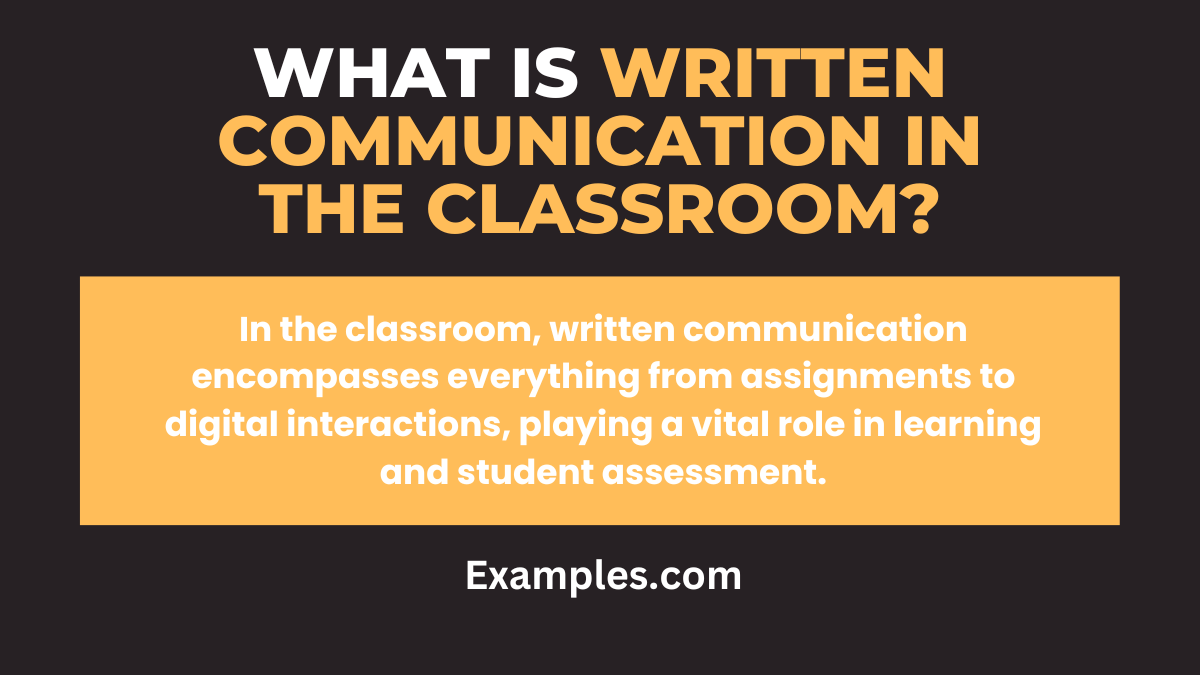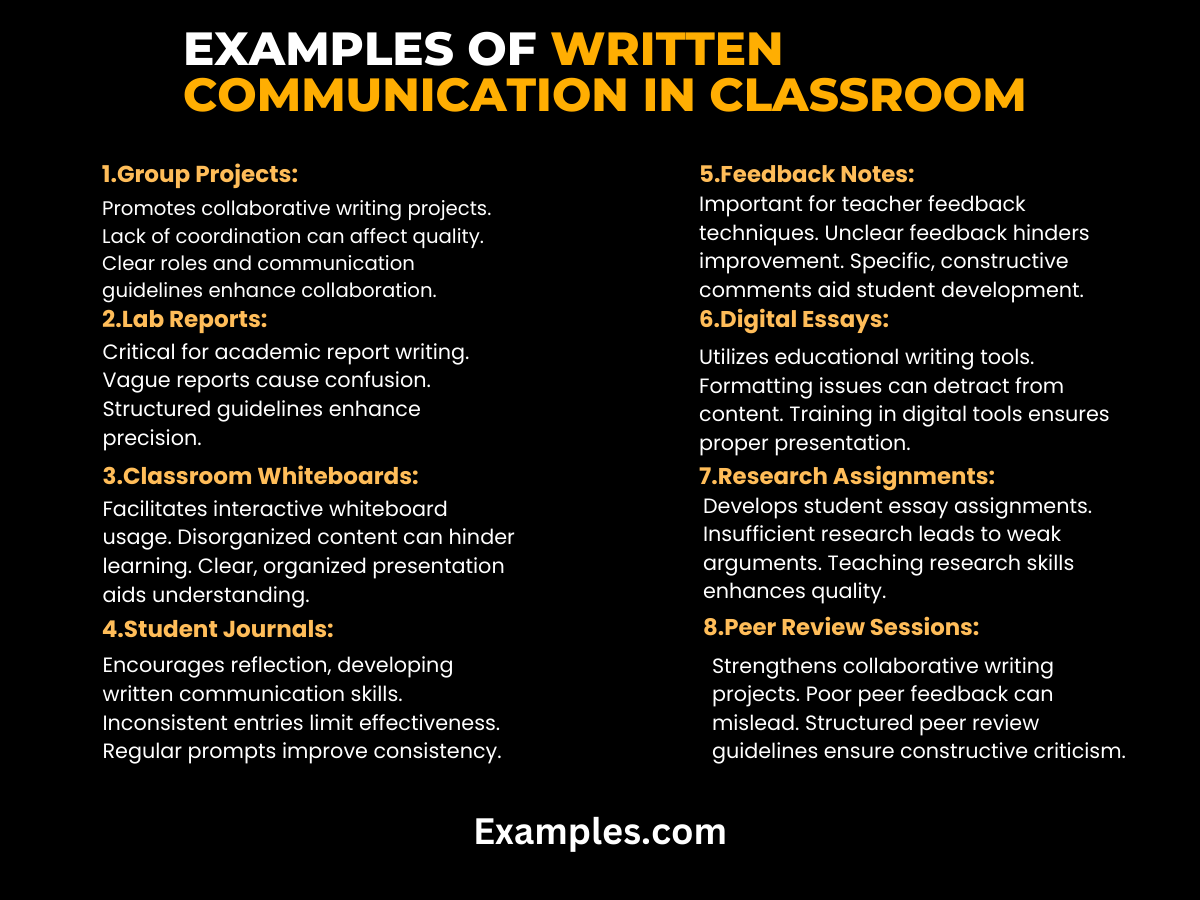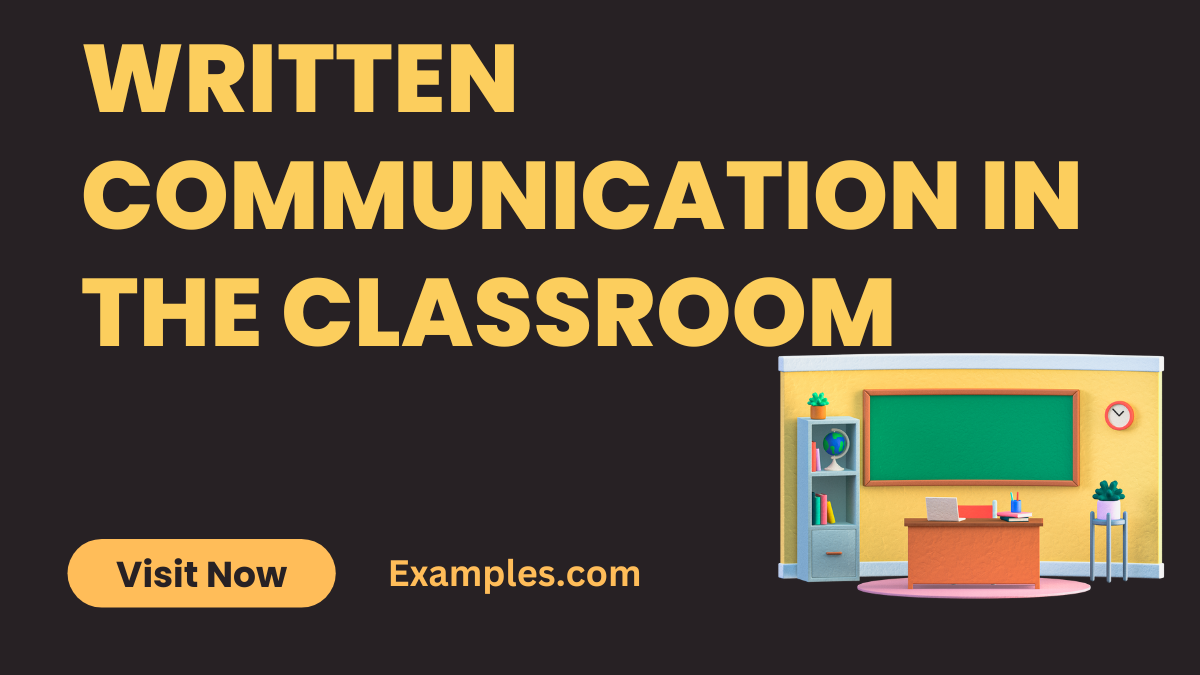9+ Written Communication in the Classroom Examples
In today’s educational landscape, the role of written communication cannot be overstated. This comprehensive guide provides an in-depth look into the myriad ways written communication manifests in the classroom. From detailed sentence examples to thought-provoking journal entries, we explore the Importance of Written Communication in shaping educational experiences. Featuring practical “Communication Examples,” this guide also delves into the Characteristics of Written Communication, equipping educators and students with the skills necessary to navigate the intricate world of written discourse in educational settings.
What is Written Communication in the Classroom? – Meaning

Written communication in the classroom refers to the exchange of information and ideas through written text. It’s an essential component of Written Communication in Education, encompassing everything from assignments and emails to interactive digital platforms. This form of communication not only aids in the dissemination of knowledge but also plays a critical role in evaluating student understanding and progress. Effective written communication skills are crucial for success in various educational contexts, including Written Communication in Schools and Written Communication in the Classroom, highlighting the need for continuous improvement in this area.
10 Written Communication in the Classroom

Written Communication in the Classroom is a dynamic tool that enhances learning and expression. This guide presents ten distinct examples, each highlighting a specific aspect of written communication and its role in the educational process. From academic report writing to interactive whiteboard usage, these examples address common challenges and propose effective solutions, illustrating how to optimize written communication for educational success.
- Essays: Enhances written communication skills. Poor structure leads to unclear ideas. Teaching essay planning improves clarity.
- Lab Reports: Critical for academic report writing. Vague reports cause confusion. Structured guidelines enhance precision.
- Classroom Whiteboards: Facilitates interactive whiteboard usage. Disorganized content can hinder learning. Clear, organized presentation aids understanding.
- Student Journals: Encourages reflection, developing written communication skills. Inconsistent entries limit effectiveness. Regular prompts improve consistency.
- Group Projects: Promotes collaborative writing projects. Lack of coordination can affect quality. Clear roles and communication guidelines enhance collaboration.
- Feedback Notes: Important for teacher feedback techniques. Unclear feedback hinders improvement. Specific, constructive comments aid student development.
- Digital Essays: Utilizes educational writing tools. Formatting issues can detract from content. Training in digital tools ensures proper presentation.
- Research Assignments: Develops student essay assignments. Insufficient research leads to weak arguments. Teaching research skills enhances quality.
- Peer Review Sessions: Strengthens collaborative writing projects. Poor peer feedback can mislead. Structured peer review guidelines ensure constructive criticism.
- Creative Writing: Boosts imagination and student writing development. Vague prompts can stifle creativity. Clear, inspiring prompts stimulate imagination.
Each example underscores the significance of integrating effective written communication strategies in the classroom, highlighting its role in fostering a comprehensive and engaging learning environment.
How do You Teach Written Communication Skills?
- Use Diverse Written Communication Sentence Examples: Introduce a variety of examples to demonstrate different writing styles and contexts. This helps students understand the versatility of written language.
- Integrate Written Communication in Education: Incorporate writing exercises and projects in the classroom to provide regular practice. This helps in embedding writing skills as a core part of the curriculum.
- Focus on Characteristics of Written Communication: Teach students about clarity, coherence, and tone. Understanding these characteristics is essential for effective written communication.
- Provide Constructive Feedback: Regular feedback helps students identify areas for improvement in their writing skills.
- Encourage Peer Review: Peer review sessions enable students to receive diverse feedback and learn from each other’s writing styles and techniques.
- Promote Writing Across Different Subjects: Including writing tasks in various subjects, such as Written Communication in Science or Written Communication in Social Studies, helps students apply their skills in diverse contexts.
Why is Written Communication Hard?
- Lack of Non-Verbal Cues: Written communication does not include facial expressions, tone of voice, or body language, making it challenging to convey emotions and nuances.
- Language Proficiency Required: Effective writing demands a good command of language, grammar, and vocabulary, which can be a significant hurdle for many learners.
- Understanding Audience and Context: Different contexts, such as Written Communication in Business or Written Communication in Healthcare, require different writing styles and jargon, making adaptability crucial.
- Organizing Thoughts Coherently: Translating thoughts into coherent, structured text is a complex skill that requires practice and understanding of the subject matter.
- Maintaining Clarity and Precision: The need for clarity and precision in written communication adds to its complexity, especially in professional and academic contexts.
- Cultural and Linguistic Differences: Differences in cultural and linguistic backgrounds among readers can lead to misinterpretation or misunderstanding of the written content.
- Constant Evolution of Language: Keeping up with evolving language trends, slang, and technical jargon can be challenging, especially in dynamic fields.
What Does Written Communication Lack?
1. Absence of Non-Verbal Cues
- Written Communication in Education: Lacks tone, facial expressions, body language.
- Impact on Learning: Non-verbal cues are crucial for understanding and engagement, especially in Written Communication in Schools.
2. Limited Immediate Feedback
- Written Communication in the Classroom: No opportunity for real-time clarifications or responses.
- Communication Challenges: Delays in resolving queries and potential for misunderstandings.
What Can Happen If You Are Not Clear With Your Written Communications?
1. Misunderstandings in Educational Contexts
- Clarity in Education: Ambiguities can negatively affect learning outcomes.
- Educational Journals and Instructions: Need for clear, unambiguous content, underlining the Characteristics of Written Communication.
2. Adverse Outcomes in Professional Environments
- Written Communication in Business: Unclear communications can lead to faulty decision-making and operational errors.
- Written Communication in Healthcare: Ambiguity can cause incorrect patient care practices, emphasizing the need for proficient Written Communication Skills.
Additional Resource Integration
- Incorporating links to Importance of Written Communication, Written Communication Sentence Examples, and How to Improve Written Communication for comprehensive understanding and skill enhancement in written communication.
Is Written Communication a Soft or Hard Skill?
Written communication is considered a soft skill. It’s an integral part of Written Communication Skills and is essential for effective interaction in various settings, including Written Communication in the Classroom and Written Communication in Business.
Is Written Communication Flexible?
Yes, written communication is flexible. It adapts to different contexts, like Written Communication in Healthcare or Written Communication in Education, allowing tailored messaging for varied audiences.
How Do You Tell Someone They Have Poor Communication Skills?
Addressing poor communication skills requires tact and clarity. Highlight specific Written Communication Sentence Examples and suggest resources like a Written Communication Journal for improvement. Emphasize the Importance of Written Communication in a supportive manner.
“Written Communication in the Classroom” from Examples.com, consider emphasizing the transformative power of effective written communication in educational settings. Highlight how mastering this skill is not only crucial for academic success but also for personal and professional development. Stress the importance of continuous learning and adapting to new communication forms, especially in the digital age.
Suggesting additional resources for readers can further enrich their understanding. For instance, the Massachusetts Institute of Technology (MIT)’s page on Teaching Writing and Communication offers valuable insights and methods for educators. Additionally, resources like the Educational Writing section from Purdue University’s Online Writing Lab (OWL) can provide practical tips and examples for students and educators alike, reinforcing the concepts discussed in the article.



